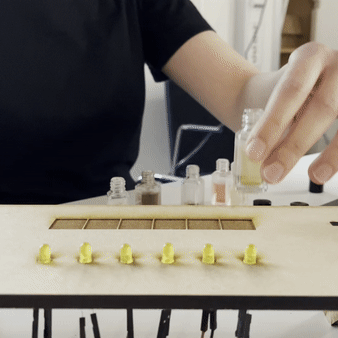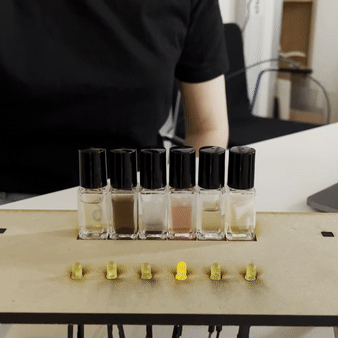Art Class Stinks!
Press
Arduino AB
Supported by
10 weeks
Duration
Tools
Arduino, Lasercutting, Miro, DIY Scent Extraction
Literature review, user research, expert interviews, design workshops, affinity mapping, cultural probes, olfactory sketching, wireframing, prototyping, user-testing
Methods
Situated in the domains of olfactory interaction and physical computing, the prototype is an interactive system for learning with smell in art class while raising the users’ awareness of olfaction. It is targeted to art students, and more specifically, adults who attend art classes for leisure. It may also be useful to adults who may not be enrolled in an art course but have taken up an artistic hobby.
The prototype consists of two components. The first component is a mobile app that guides the user through the process, gives instructions for creative tasks and smell awareness tasks, and archives the users’ art. The second component is an olfactory display that consists of an interactive board (equipped with RFID sensors and LED lights) and a scent kit (6 glass vials). The olfactory display is linked with the mobile app software.
Problem domain
Smell is crucial to our everyday life, it can enrich learning, and holds potential as an art material.
Despite that:
Smell is often overlooked in art education
Smell has not been widely explored in the field of HCI
This led to the research question:
How can olfactory interaction design provide ways for art students to learn with smell in art class, while becoming more aware of their sense of smell?
Design Model
The Double Diamond
Why did I use the Double Diamond model?
It is ideal for efficient time management.
Be structured while navigating a hardly-known field.
What did I have to change?
This model is not flexible, but I allowed iterations.
I let some phases overlap as long as I didn’t miss any deadlines.
Short summary of my design process
I knew that the sense of smell hasn’t been widely explored in HCI, but didn’t have a solid research question yet, so:
I dove into a literature review, reading about olfactory interaction, collecting relevant design examples, and laying a theoretical foundation for my project.
I conducted 5 expert interviews with olfaction experts from 5 countries in my attempt to get out of the library and situate the project in the real world.
At the same time, I conducted a design workshop for both user research and material exploration.
I then synthesized insights from the previous activities and decided I had to do an extra interview, plus some more reading.
I was then able to formulate a solid research question, and sent out 8 cultural probes to bridge research and sketching.
Moving on to sketching, I produced several olfactory sketches, some of which were the first iterations of my prototype.
I then designed a prototype.
I conducted user-testing with 7 people to evaluate it.
My design process
Step by step
Expert interviews, in a semi-structured format
A design activity for user-research
Aiming to identify:
what the experts work with
what methods they employ
what potential they see in working with olfaction
what challenges they face in their work.
Here are the key insights:
“The smell experience for humans is not one single combined smell, but the sum of a number of parts” [McLean]
Smell abled people are not adequately trained to work with olfaction, they are unaware of its potential, and thus often underestimate smell.
Fragrant Art Workshop
A design workshop for user research & material exploration
Aiming to:
explore DIY scent extraction techniques
see how users respond to using smell for art
Info:
60 min workshop, 5 participants
all migrants in Sweden, all attended art classes
Prep before the workshop:
Asked each participants to pick 10 scents (5 from home country, 5 from Sweden)
Replicated 12 of those scents using DIY techniques
During the workshop:
Each participants smells a scent vial,
Talks from/ about their olfactory experience,
Creates art inspired by each scent
Here are the key insights:
Ueda’s scent extraction technique is easy & effective
Each participant could only guess half of the scents on average
The participants were surprised by their emotional reaction to the scents
The participants had never intentionally used scents in art class before
Most participants were eager to incorporate smell in their art again
Probes stink!
Cultural probes for user research and preliminary sketching
Info:
8 participants, all have attended art classes
3 creative tasks, 1 evaluation task
to be completed over the course of 5 days
The workshop made me realize that users had a hard time identifying scents out of context. As a result, for the next activity, I decided to replicate a smellscape instead of isolated scents, to see if people can identify scents more easily that way.
Participants go for a smell-walk to warm up their smelling ‘muscles'
They are given 6 scent vials, each with an isolated scent note.
They smell the vials in rapid succession (that way, the scents simulate the smellscape of a greengrocery shop).
They visualize the scent harmony, and then use keywords to visualize each scent note.
Here are the key insights:
Most participants could identify the smellscape
Most participants could identify the majority of the scent notes
It’s easier to identify a scent note after smelling it as part of a scent harmony
Completing several olfactory tasks helps users become more aware of their sense of smell, regardless of experience
The wording task was vague and confusing
the probes were a way for me to sketch the interaction between the users and the smellscape, and between the users and the smell related creative tasks
Olfactory sketching
while involving users in the sketching process
Why did users participate in my sketching process?
Smell is subjective
Olfactory sketching is heavily based on sensory input processing
As a result, I couldn’t make decisions based on my senses only
I invited 2 users to try out my sketches and give feedback
What did I sketch?
Several variations of an olfactory display, using scent vials, cardboard, and an Arduino board.
I tried out two different types of scent delivery, and several smelling choreographies.
Here are the key insights from sketching:
Fans disperse the odors, spreading them over a wide area, which makes smelling confusing when multiple scent notes are involved.
The odor of the cardboard box overpowered the odor of the scent vials.
Smelling the scent vials at a pace indicated by the LED lights is more meaningful and easy to follow.
Prototyping and User-testing
Coming up with a final design and testing with 7 users
UX/ UI: Future work
Olfactory display: ergonomic design/ materiality
place the LEDs where users can easily see them
interactive board from odorless material
hide the color of the vials’ content
RFID tag reader needs more space
Mobile app: missing features
sonic feedback in key steps like completing tasks
button for going back a step/ undo action
multiple choice difficulty increases as user progresses
Further investigation
have users test the creative tasks in collaboration with experts in art education and pedagogy
Risks
Inaccessibility: people with permanent anosmia or severe sight-impairments
Heavy on visualization: might enforce the Western world’s visual hegemony instead of proposing an alternative
Cultural appropriation: inappropriate or for-profit simulation of smellscapes that are important for non-Western cultures, such as religious spaces
PTSD/ respiratory conditions: irresponsible/ thoughtless choice of scents might trigger PTSD, allergies, or asthma
Contribution & Potential
Art students, Art Hobbyists, Art educators
help integrate olfaction in learning/ teaching process
help students become more aware of smell and its potential as an art material
expands art teachers’ current repertoire of teaching methods/ activities
help art teachers who struggle to explain why smell is important
Smell training/ smell awareness
breathing over multiple scent notes that constitute a smellscape has not been widely explored
may highlight the importance of smell in our lives
Interaction Designers/ Researchers
contributes to the field of embodied interaction/ olfactory interaction
informs about challenges & potential of working with olfaction,
as well as other unfamiliar sense modalitiesadds to the existing state of the art of olfactory displays
Discussion between disciplines
interaction design, UX design, education, art, art education, smell training
The Prototype
You made it this far! Why not check out other projects too?
Space Elevator VR | The Soundmat | Casa Populare | The Palimpsest Website | Greater Spaces



















